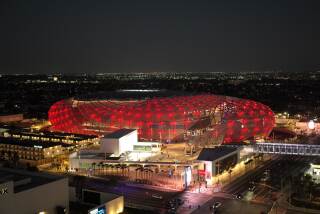Wayne McAllister; Architect Designed Restaurants, Casinos
Wayne McAllister, one of the West’s greatest unsung architects, who designed pioneering playlands on the Las Vegas Strip, circular kitchens and landmark eateries ranging from the Cinegrill supper club in Hollywood to the concrete-crescent Bob’s Big Boy in Toluca Lake, has died. He was 92.
McAllister, who continued working in his Alhambra real estate sales office until his death, fell and struck his head and then died on March 22 in Arcadia, said architecture preservationist Chris Nichols.
As former chairman of the Los Angeles Conservancy’s Modern Committee, Nichols spearheaded an exhibit of McAllister’s work at the Pacific Design Center in 1998.
The conservancy committee led efforts in 1992 to have the Bob’s Big Boy on Riverside Drive declared a California State Point of Historical Interest. The building, the third Bob’s ever built and the oldest still in existence, is considered an excellent transitional example of 1940s Moderne architectural style melding toward the 1950s “coffee shop modern” endemic in Los Angeles.
“As far as I was concerned,” McAllister told The Times at the time of the 1998 exhibit, “I just ran a modest office and did modest work. It didn’t deserve any special publicity or attention at the time.”
He often said that he simply tried to design things to fulfill a need and that his eye-catching futuristic buildings were “influenced by the automobile, not the architect.”
But architectural historian Alan Hess, who praised McAllister in two books, “Viva Las Vegas” and “Googie: Fifties Coffee Shop Architecture,” and lectured at the McAllister exhibit, said that Las Vegas and Los Angeles would have been far drearier places without the architect’s work.
Hess and others have praised McAllister’s use of nonstop neon and streamlined buildings that catered to the evolving car culture.
“When you consider how good they are and how bad they might have been,” Hess said of McAllister’s hotels and restaurants, “you can gather how significant his influence has been in Southern California and the nation.”
McAllister grew up in San Diego, where a vocational counselor suggested that the handsome, artistic teenager pursue architecture or acting. He studied design in night school and became an apprentice to what he described as a “cowboy architect.” Offered a full-time job, McAllister dropped out of high school and accepted--just as the boss absconded with a few thousand dollars of clients’ funds, leaving McAllister the sole proprietor.
In 1927 McAllister, then 20, designed the Tijuana resort of Agua Caliente, which would be frequented by Clark Gable, Jean Harlow and Gloria Swanson.
The young architect moved to Los Angeles as Prohibition came to an end. He made a name for himself installing tony hotel cocktail lounges around town--at the vast Biltmore Bowl, the Roosevelt’s Cinegrill and the Town House’s Zebra Room on Wilshire Boulevard.
In the 1930s, he designed 24-hour carhop restaurants such as the Pig ‘n Whistle at Wilshire and Western boulevards, Simon’s and Hebert’s and Van de Kamp’s drive-ins that can still be seen in classic film noir.
McAllister also advised Stanley Meston, a protege, on a project to pierce the roof of the first franchised McDonald’s with a pair of golden arches.
When Nichols was delving into McAllister’s legacy, the architect casually mentioned that he also had designed the first franchise restaurant for Kentucky Fried Chicken.
The California architect conjured classier eateries as well--Lawry’s, Richlor’s and Stears for Steaks on La Cienega’s Restaurant Row--and expanded the Los Feliz Brown Derby and Atwater Village’s Tam O’ Shanter.
In April 1941, five years before Bugsy Siegel completed the Flamingo hotel and casino, McAllister set the mold for the Las Vegas Strip when he designed the fanciful dude ranch called the El Rancho Hotel. One of the first of myriad theme hotels, El Rancho fairly lassoed high-rollers with its chuck wagon murals, rambling bungalows and cowpoke casino.
McAllister went on to work with Siegel on the original plans for the Desert Inn. The architect also designed the Sands, the setting for entertainment by and for Frank Sinatra and Dean Martin’s Rat Pack, and a couple of Las Vegas’ oldest still-standing hotel casinos, the Fremont and the Horseshoe.
But the accidental architect chucked the whole business in 1956 and moved to Washington, D.C., to become vice president of Marriott Corp. He returned to Los Angeles in 1962, but not to architecture.
Since then, he had developed the first coin-operated copying machines, and ran a small business selling copiers and, in recent years, tract houses.
McAllister is survived by his wife of 75 years, Corinne, and three children, Donald, David and Paulette.


